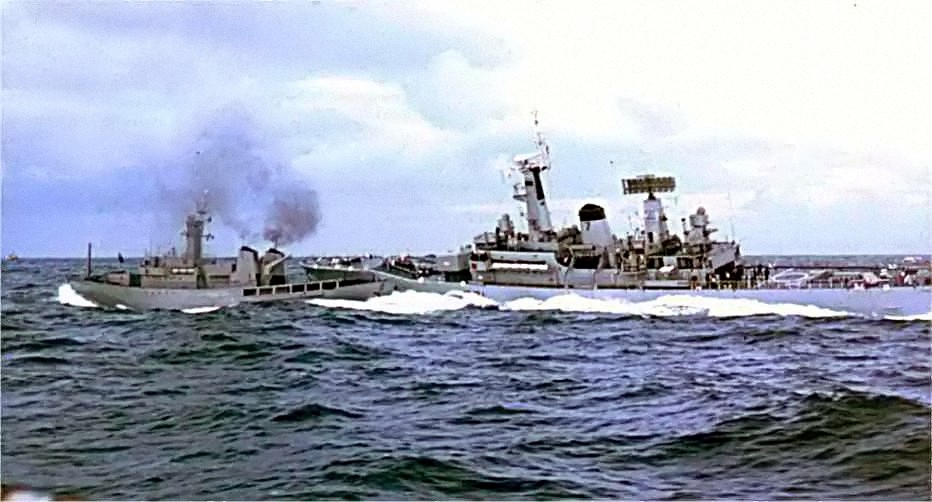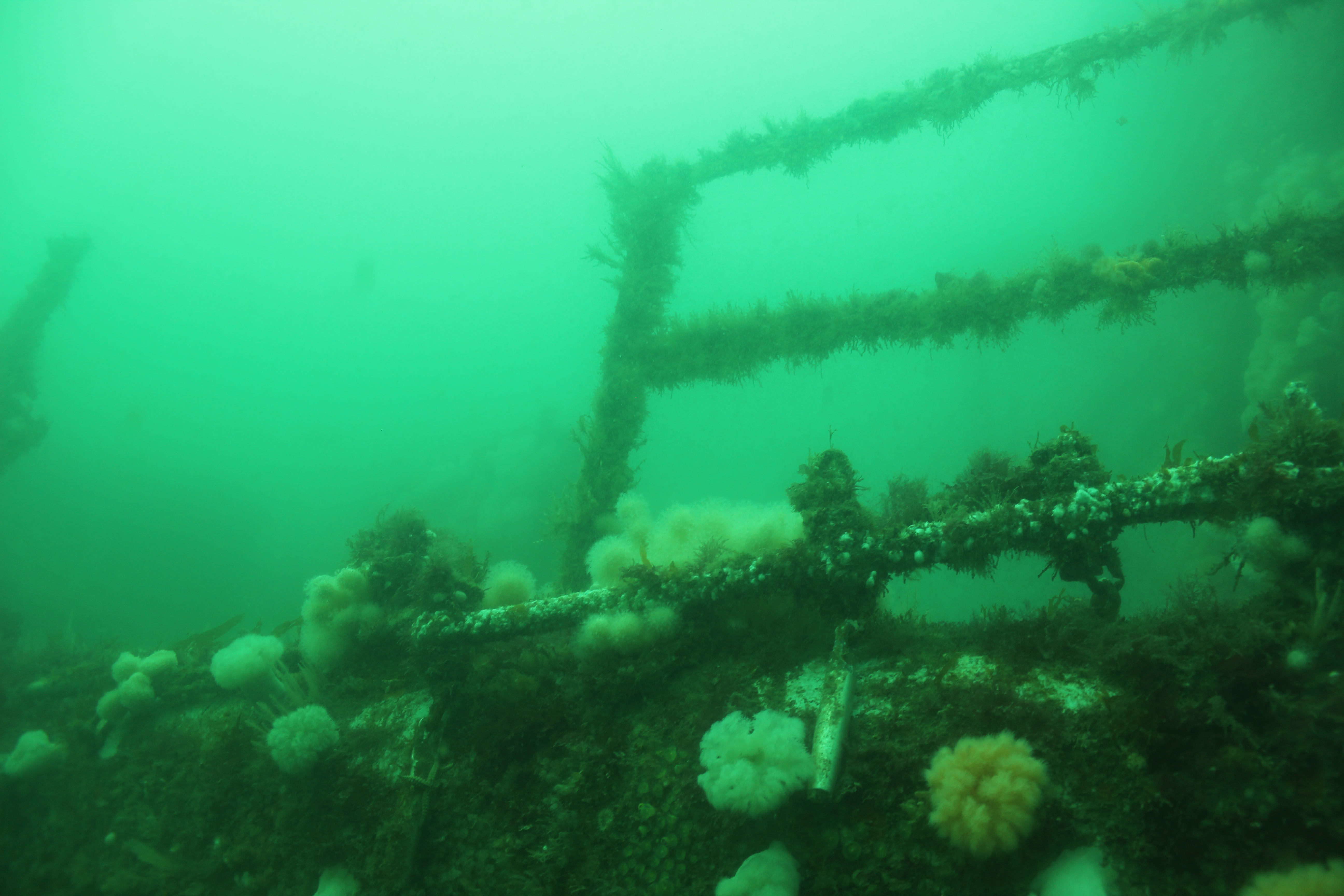HMS Scylla (F71) on:
[Wikipedia]
[Google]
[Amazon]
HMS ''Scylla'' (F71) was a of the Royal Navy (RN). She was built at Devonport Royal Dockyard, the last RN frigate to be built there as of 2016. ''Scylla'' was commissioned in 1970, taken out of service in 1993 in accordance with Options for Change, and sunk as an artificial reef in 2004 off Whitsand Bay, Cornwall.
 On 22 January 1973, ''Scylla'' collided with the Torpoint ferry, one of three separate collisions involving four warships on the same day. ''Scylla''s collision had occurred while on sea trials following a refit. While ''Scylla'' resumed her journey, the ferry sustained a gash at the bow. A court martial in May reprimanded ''Scylla''s commanding officer, Captain Peter Sutton. In May, ''Scylla'' was deployed with other frigates to support the Royal Navy's operations against Iceland during the Second Cod War. The frigate conducted patrols to counter Icelandic coast guard ships targeting fishing vessels. On 1 June, the Icelandic gunboat ''Aegir'' collided with ''Scylla'', the first such incident to occur during the fishing dispute.
Fishing relations with Iceland deteriorated further in 1975, and the dispute escalated into the Third Cod War. From February 1976, ''Scylla'' began operating in support of British fishing trawlers. In May, ''Scylla'' provided the escort to the
On 22 January 1973, ''Scylla'' collided with the Torpoint ferry, one of three separate collisions involving four warships on the same day. ''Scylla''s collision had occurred while on sea trials following a refit. While ''Scylla'' resumed her journey, the ferry sustained a gash at the bow. A court martial in May reprimanded ''Scylla''s commanding officer, Captain Peter Sutton. In May, ''Scylla'' was deployed with other frigates to support the Royal Navy's operations against Iceland during the Second Cod War. The frigate conducted patrols to counter Icelandic coast guard ships targeting fishing vessels. On 1 June, the Icelandic gunboat ''Aegir'' collided with ''Scylla'', the first such incident to occur during the fishing dispute.
Fishing relations with Iceland deteriorated further in 1975, and the dispute escalated into the Third Cod War. From February 1976, ''Scylla'' began operating in support of British fishing trawlers. In May, ''Scylla'' provided the escort to the
 The ship was bought by the
The ship was bought by the
Construction and career
In early 1966, theBritish Admiralty
The Admiralty was a department of the Government of the United Kingdom responsible for the command of the Royal Navy until 1964, historically under its titular head, the Lord High Admiral – one of the Great Officers of State. For much of it ...
ordered ''Scylla'', a "Broad-Beam" ''Leander''-class frigate, from Devonport Dockyard,Osborne and Sowdon 1990, p. 38. at a cost of £6,600,000. ''Scylla'' was laid down on 17 May 1967, launched on 8 August 1968 and commissioned on 14 February 1970, receiving the pennant number
In the Royal Navy and other navies of Europe and the Commonwealth of Nations, ships are identified by pennant number (an internationalisation of ''pendant number'', which it was called before 1948). Historically, naval ships flew a flag that iden ...
F71.Osborne and Sowdon 1990, p. 109.
1970s
 On 22 January 1973, ''Scylla'' collided with the Torpoint ferry, one of three separate collisions involving four warships on the same day. ''Scylla''s collision had occurred while on sea trials following a refit. While ''Scylla'' resumed her journey, the ferry sustained a gash at the bow. A court martial in May reprimanded ''Scylla''s commanding officer, Captain Peter Sutton. In May, ''Scylla'' was deployed with other frigates to support the Royal Navy's operations against Iceland during the Second Cod War. The frigate conducted patrols to counter Icelandic coast guard ships targeting fishing vessels. On 1 June, the Icelandic gunboat ''Aegir'' collided with ''Scylla'', the first such incident to occur during the fishing dispute.
Fishing relations with Iceland deteriorated further in 1975, and the dispute escalated into the Third Cod War. From February 1976, ''Scylla'' began operating in support of British fishing trawlers. In May, ''Scylla'' provided the escort to the
On 22 January 1973, ''Scylla'' collided with the Torpoint ferry, one of three separate collisions involving four warships on the same day. ''Scylla''s collision had occurred while on sea trials following a refit. While ''Scylla'' resumed her journey, the ferry sustained a gash at the bow. A court martial in May reprimanded ''Scylla''s commanding officer, Captain Peter Sutton. In May, ''Scylla'' was deployed with other frigates to support the Royal Navy's operations against Iceland during the Second Cod War. The frigate conducted patrols to counter Icelandic coast guard ships targeting fishing vessels. On 1 June, the Icelandic gunboat ''Aegir'' collided with ''Scylla'', the first such incident to occur during the fishing dispute.
Fishing relations with Iceland deteriorated further in 1975, and the dispute escalated into the Third Cod War. From February 1976, ''Scylla'' began operating in support of British fishing trawlers. In May, ''Scylla'' provided the escort to the royal yacht
A royal yacht is a ship used by a monarch or a royal family. If the monarch is an emperor the proper term is imperial yacht. Most of them are financed by the government of the country of which the monarch is head. The royal yacht is most often c ...
during Queen Elizabeth II's state visit to Finland. ''Scylla'' attended the Spithead Fleet Review, held in honour of Queen Elizabeth II's Silver Jubilee. During that review ''Scylla'' was situated between and sister ship
A sister ship is a ship of the same class or of virtually identical design to another ship. Such vessels share a nearly identical hull and superstructure layout, similar size, and roughly comparable features and equipment. They often share a ...
.
1980s
In 1980, ''Scylla'' provided support when Cayman Brac, part of theCayman Islands
The Cayman Islands () is a self-governing British Overseas Territory—the largest by population in the western Caribbean Sea. The territory comprises the three islands of Grand Cayman, Cayman Brac and Little Cayman, which are located to the ...
, was struck by a powerful hurricane. ''Scylla'' went into refit in 1980, to provision the frigate with Type 2016 sonar, Exocet and Sea Wolf missile launchers, and a Westland Lynx helicopter. The refit lasted four years, and cost £79,692,000, rendering the frigate unavailable for service in the Falklands. After being recommissioned, ''Scylla'' acted as guard ship for the West Indies and patrolled the Persian Gulf as part of Armilla Patrol.. In November 1986 at the end of her first Armilla Patrol, she was the escort to ''Britannia'' during the Prince and Princess of Wales
Princess of Wales (Welsh: ''Tywysoges Cymru'') is a courtesy title used since the 14th century by the wife of the heir apparent to the English and later British throne. The current title-holder is Catherine (née Middleton).
The title was firs ...
' visit to the Middle East firing a Royal Salute off Matrah
Muttrah, ( ar, مطرح) administratively a wilayah (province), is located in the Muscat Governorate of Oman. Before the discovery of oil in Oman, Muttrah was the center of commerce in Oman (Muscat). It is still a center of commerce as one of t ...
, Oman and also visiting Jiddah. The Princess of Wales flew home from Hurghada and ''Syclla'' then escorted ''Britannia'' north through the Suez Canal
The Suez Canal ( arz, قَنَاةُ ٱلسُّوَيْسِ, ') is an artificial sea-level waterway in Egypt, connecting the Mediterranean Sea to the Red Sea through the Isthmus of Suez and dividing Africa and Asia. The long canal is a popular ...
and on to Akrotiri, Cyprus where Prince Charles disembarked. While on Armilla Patrol in late December 1987, ''Scylla'' and twice intervened after two ships, the Korean ''Hyundai No 7'' and British ''Eastern Power'', were targeted by Iranian gunships. After the Korean vessel had been attacked south of Abu Musa Island, ''Scylla''s crew launched the frigate's Westland Lynx helicopter and evacuated some of the ship's crew.
1990s
In 1990, ''Scylla'' underwent a 10-month refit at Rosyth. By 1993, ''Scylla'' had become the last representative of her class in active service. The frigate's last deployment came that year when she deployed to the South Atlantic. By then she was showing her age, and it had become difficult for the ship's engineers to maintain. ''Scylla'' suffered steering problems while on patrol and collided with the accompanying tanker . While ''Scylla'' suffered only superficial damage, ''Gold Rover'' had to have repairs for hull damage. ''Scylla'' was decommissioned in December 1993. In 1992, ''Scylla'', with the commanding officer, officers and members of the ship's company in attendance, was granted the Freedom of the City of Aberdeen.Sinking and use as a dive site
 The ship was bought by the
The ship was bought by the National Marine Aquarium National Marine Aquarium may refer to:
* National Marine Aquarium of Namibia
* National Marine Aquarium, Plymouth
The National Marine Aquarium, located in Britain's Ocean City Plymouth is the largest Aquarium in the UK. It is home to over 4,0 ...
for £200,000 and on 27 March 2004 ''Scylla'' was sunk off Whitsand Bay, Cornwall, to form the first such artificial reef in Europe. The ship was 'planted' on a sandy seabed at approximately from the wreck of the Liberty ship , which has been a dive site for many years.
Within three months of sinking the wreck was colonised by sea anemone
Sea anemones are a group of predation, predatory marine invertebrates of the order (biology), order Actiniaria. Because of their colourful appearance, they are named after the ''Anemone'', a terrestrial flowering plant. Sea anemones are classifi ...
, mussel
Mussel () is the common name used for members of several families of bivalve molluscs, from saltwater and Freshwater bivalve, freshwater habitats. These groups have in common a shell whose outline is elongated and asymmetrical compared with other ...
s and scallop
Scallop () is a common name that encompasses various species of marine bivalve mollusks in the taxonomic family Pectinidae, the scallops. However, the common name "scallop" is also sometimes applied to species in other closely related families ...
s and by six months sea urchin
Sea urchins () are spiny, globular echinoderms in the class Echinoidea. About 950 species of sea urchin live on the seabed of every ocean and inhabit every depth zone from the intertidal seashore down to . The spherical, hard shells (tests) of ...
and starfish
Starfish or sea stars are star-shaped echinoderms belonging to the class Asteroidea (). Common usage frequently finds these names being also applied to ophiuroids, which are correctly referred to as brittle stars or basket stars. Starfish ...
were found in large numbers. By 2021, 250 species have been recorded.
In 2007 two amateur divers were killed after entering the wreck. Two more experienced divers died inside the engine room on deck three in September 2021. There are fears that the continuing deposition close to the wreck of dredged waste from the Tamar estuary has led to large quantities of silt spreading through the ship and frequently mixing with the moving water reducing visibility, thereby preventing divers from finding their way out before their air supply diminishes. Following a 2014 survey the National Marine Aquarium who manage the site advised divers not to enter the wreck and solely to undertake scenic dives.
References
Publications
* * Marriott, Leo, 1983. ''Royal Navy Frigates 1945-1983'', Ian Allan Ltd. * * Roberts, John (2009), ''Safeguarding the Nation: The Story of the Modern Royal Navy'', Seaforth Publishing. {{DEFAULTSORT:Scylla (F71) 1968 ships 1973 in England Cornish shipwrecks Leander-class frigates Maritime incidents in 1973 Ships built in Plymouth, Devon Ships of the Fishery Protection Squadron of the United Kingdom Ships sunk as artificial reefs Ships sunk as dive sites Shipwrecks in the English Channel Wreck diving sites in England